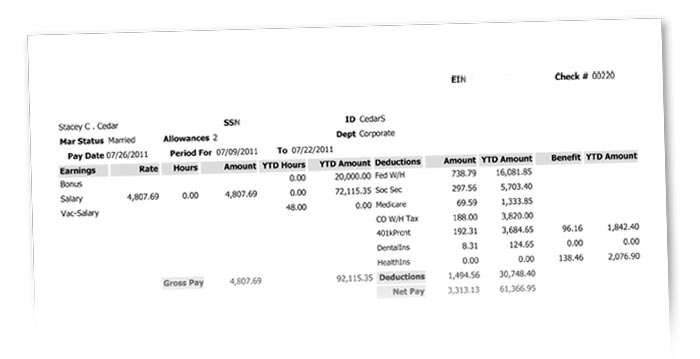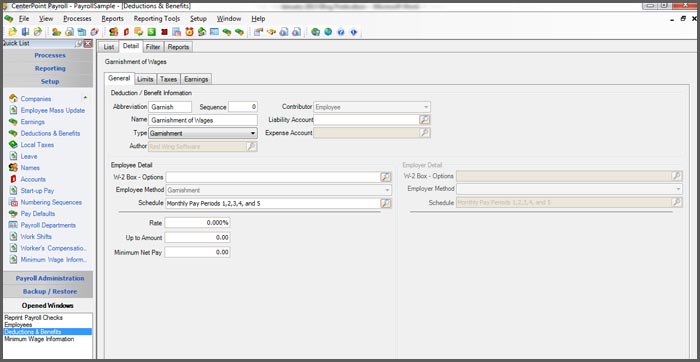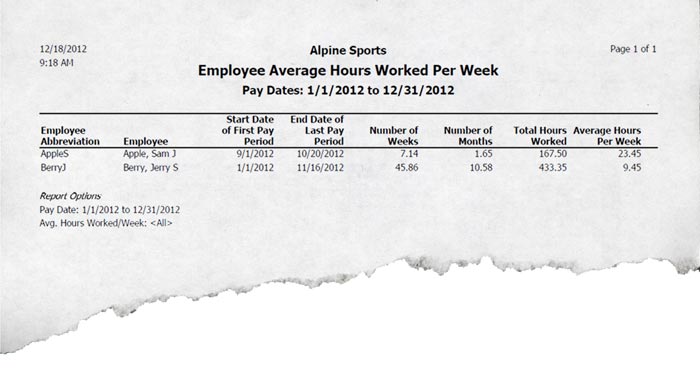By Stephanie Elsen
Can a whole blog post be written about pay stubs? Well, if you manage payroll, you know pay stubs are important! A pay stub is the piece of paper an employee receives that contains information about their pay. If they receive a printed pay check, it’s typically attached to the check. If their pay is direct deposited or distributed on a pay card, the paper is simply handed out to those employees. Some employers even go a step further and offer electronic pay stubs, which eliminates the need for paper and allows employees to access their pay information securely online. No matter the form they take, the pay stub is necessary so employees can access information and details about their pay, employment, and benefits. Here are some things you should know about printed pay stubs.
Here are examples of some of the standard pay stub types available with a payroll system. What you put on the pay stubs for your employees largely depends on your company, the benefits you provide, and which information you and your employees need to see (or not to see).
- Standard Pay Stub
- Standard with Leave & Deductions Pay Stub
- Standard with Benefits Pay Stub
- Piece Rate Pay Stub
- Standard with Piece Rate Pay Stub
- Standard without YTD Hours Pay Stub
- Standard without Leave Pay Stub
While many payroll software systems offer a standard set of payroll stub variations, some systems also allow you to design your own pay stubs, so they are exactly as your company and its employees with to see them. Red Wing Software’s CenterPoint Payroll does allow for designing of custom pay stubs with its Check Stub Designer, which is an optional add-on product.
Placement of the pay stub can vary greatly, and that’s why many payroll systems offer the ability to choose where the check and the pay stub are on the check paper stock. The page is typically divided into three sections, with one section being for the check itself, one section for the employee stub and the other section for the stub which the employer keeps.
Some payroll systems also offer users the option of providing electronic pay stubs. Employees are then able to access their current and prior pay data online, from any computer via the internet. This eliminates the need for paper pay stubs, and is also convenient way to provide employees in multiple states or locations with their pay information.
It is important to choose a payroll system that can create pay stubs for your company and its employees in a way that makes the most sense for you.

Pay Stub Sample – CenterPoint Payroll Software
The SBA has launched a new page helping businesses make sense of health care reform. Check out this link for the full story.
http://www.bizjournals.com/wichita/news/2013/01/29/small-business-administration-launches.html?page=all
By Stephanie Elsen
As an employer, you are aware of the importance of making accurate employee wage garnishments. Calculating withholdings and making payments can be complex, and processing them incorrectly can result in legal repercussions. Here are some ways payroll software can help ensure deductions are made accurately and on time.
Set up and track garnishment calculations. By setting up garnishment calculations to compute automatically when payroll is processed, you are assured a consistently accurate dollar amount is being withheld, keeping both employee and creditor happy.
Set up and pay garnishment creditors from your payroll system. By setting up creditors within your payroll system, you can easily process and send checks right from the system instead of having to look up the address and print the check from another location. This also provides the ability to run reports to see who has been paid, and how much.
Specify a minimum net pay. Many garnishment court orders require that an amount be deducted from the pay, yet the employee pay should not go below a specified amount. By setting this up within your payroll system, you are confident the proper garnishment is taken out, and that the employee gets their minimum amount.
Set up a garnishment priority. When an employee has more than one garnishment, you will need to know which garnishment takes priority. Setting up a priority system within your software allows you to automatically deduct the garnishment in the correct order, so that the proper amount is deducted for each creditor.
Specify the priority of other deductions. A garnishment may be set up to allow the employee to contribute money to other areas before the garnishment is taken, such as a 401(k) contribution. In this case, setting up a rule within your system to handle this will make certain that the garnishment is taken only after the other deductions are taken.
Employee payroll garnishments can be complicated. Use every tool at your disposal to ensure you are in compliance with a court-ordered garnishment, and look after the needs of your employee at the same time. Payroll software is a tool that can work wonders in keeping both parties satisfied.

Wage Garnishment Setup in CenterPoint Payroll Software
By Stephanie Elsen
Businesses in the U.S. know that the Patient Protection and Affordable Care Act (PPACA), also known as Obamacare, is making some big changes that affect businesses. Top of mind for many is the requirement that businesses with more than 50 full time employees must offer their full time employees health coverage. (Full time is considered 30 hours or more.) It is important then, that starting in 2014, employers can accurately determine which of their employees qualify as full time employees. And that’s why starting to track the right information in 2013 is a good idea.
So, who qualifies as a full time employee? In order to determine that, each employer chooses a time frame in which to determine full time eligibility, ranging from three months up to twelve months. Whatever length of time is used to determine full time eligibility is also the length of time which they must offer health care coverage. For example, if they are looking at a three month time frame to determine eligibility, then those who qualify must be offered the coverage for three months.
Some types of employers have a difficult job ahead of them in determining which employees are full time. In businesses where there are many part time employees, some of those employees may work enough hours to qualify as full time. Perhaps an employee works many extra hours one month, filling in often when others are sick or simply taking someone else’s hours for them. Will you know which employees are approaching full time eligibility? Are you ready for the 2014 reporting requirement?
Red Wing Software’s CenterPoint Payroll Software is now ready with a report to help users determine which employees are eligible, for whatever time frame is chosen. The report shows the employee name, the dates of the employee’s first and last pay period, number of weeks worked, number of months worked, the total hours worked, and then the average hours worked per week. This report is included standard within CenterPoint Payroll, so users will be able to view the report all throughout 2013 to monitor which employees are eligible. Once health care coverage becomes required in 2014, users will be prepared with a report to verify who is eligible. The report will be available in 2013.

Preview of the “Employee Average Hours Worked Per Week” Report
This post is by Bruce Senti of Aatrix State and Fed Payroll Reports
Compliance will be the BIG topic for 2013.
As the recent political environment has shown, the idea that tax policy will change little in 2013 is laughable. The federal government will continue to struggle with necessary change and no one knows exactly what direction tax code and legislation will go.
What we do know is that with the implementation of universal health care and ever-growing deficits, every taxing authority is likely to be impacted.
The most obvious outcome of such volatility is that change in rates, formats, forms, and filing requirements are a certainty. Keeping up with those changes and remaining in compliance will be an even more difficult task for payroll administrators than it has been in the past.
As states attempt to comply with new federal standards and respond to their own fiscal needs, it is more likely that there will be multiple changes during the next twelve months.
Forms will change to accommodate new taxes, changing rates, and increased limits as well as new calculations required for compliance. More and more businesses will be required to eFile as agencies seek to save money by eliminating paper forms.
What administrators can do to insure compliance.
In the past it would really boil down to two options: Businesses could hire additional staff to monitor the changes that affect their business or they could rely on compliance professionals that work for filing services or payroll services and outsource their process. These two options tend to be very expensive and eliminate the ability to control their own payroll start to finish.
In the last seven or more years, a new option has emerged as payroll software companies have partnered with payroll reporting software and eFiling services to take advantage of the compliance expertise inherent in those companies to assist their customers in meeting the changing environment.
A solution that is fully integrated into the payroll software is the best choice. It eliminates the need to transfer manual reports or transcribe info to a third party. It provides a familiar interface and improved accuracy as the actual paycheck data is used to produce the filing information.
Taking advantage of a company that deals with compliance every day is the safest way to insure your company is compliant. If your software has not partnered with an eFile and compliance service you may need to re-evaluate whether different software may be appropriate.